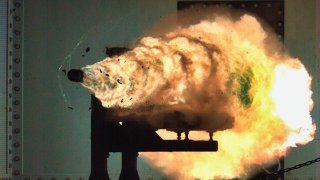U.S. Military Is Freaked: Lasers Are No 'Magic Bullet' to Kill Hypersonic Missiles
Lasers may be the cure for whatever ails you in science fiction, but if America is looking for a real solution to the myriad problems posed by modern hypersonic weapons, lasers – or directed energy weapons – won’t be able to provide the magic bullet that we’re looking for.
Thermal Blooming
As a laser continues to fire in the exact same direction for an extended period, it heats up the air it passes through, which ultimately defocuses the laser beam. This isn’t a real issue when engaging a missile from the side or at an angle as the missile flies through the sky, but it becomes a huge problem with engaging a missile that’s flying straight at you.
As a result, lasers will not be an effective means of self-defense until the amount of power they produce is so immense that they can destroy a target in a split second.
Beam control
Of course, thermal blooming is only a problem if you can keep your laser pointed in the same direction while riding a warship moving at high speeds on the open ocean. In order to be effective, a laser needs to stay focused on a single point on the target as it heats up and burns through it – and there are multiple programs aimed at doing just that like Position Sensing Devices (PSD), Fiber Optic Gyros (FOG), Fast Steering Mirrors (FSM). However, as of 2018, Deputy Director of the Missile Defense Agency Jon Hill stated in no uncertain terms all of these efforts were still working with margins “thousands of times wider” than those required for missile defense.
HOW LASERS REALLY CAN AID IN THE MISSILE DEFENSE EFFORT
Technology has advanced so rapidly throughout the 20th and 21st centuries that it seems irresponsible to ever count a concept out. Overcoming engineering challenges is, more often than not, simply a question of time, resources, and investment – and the U.S. Defense Department is exceedingly good at giving contractors at least two of those things. But, from where laser technology sits today, it has far more likely applications as a supplement to close-range defenses like the close-in weapon system (CIWS) than it does for taking down hypersonic missiles.
However, that doesn’t mean lasers don’t offer a significant (and growing) benefit to defense. Eventually, high-powered lasers will likely exceed the capabilities of systems like the 20mm CIWS, reducing the costs associated with close-in defense and offering a wide variety of new applications for close-in defensive systems. (Because laser power can be adjusted, such systems would even allow for more escalating options in limited engagements). Over time, the range of these systems will likely grow to many miles and they’ll be incorporated into other systems to supplement targeting data for battle networks and more.
But, at the end of the day, lasers in the real world are limited by physics in ways they never were in the science fiction we’ve grown up with. Will lasers ever become the all-purpose solution they’re often perceived to be? Maybe… but I wouldn’t bet against kinetic options any time soon.
About the Author: Alex Hollings
Alex Hollings is a writer, dad, and Marine veteran.
This article was first published by Sandboxx News.


